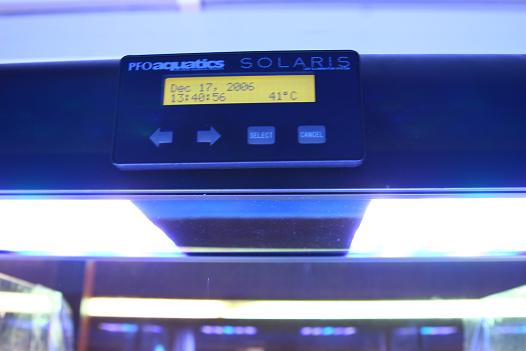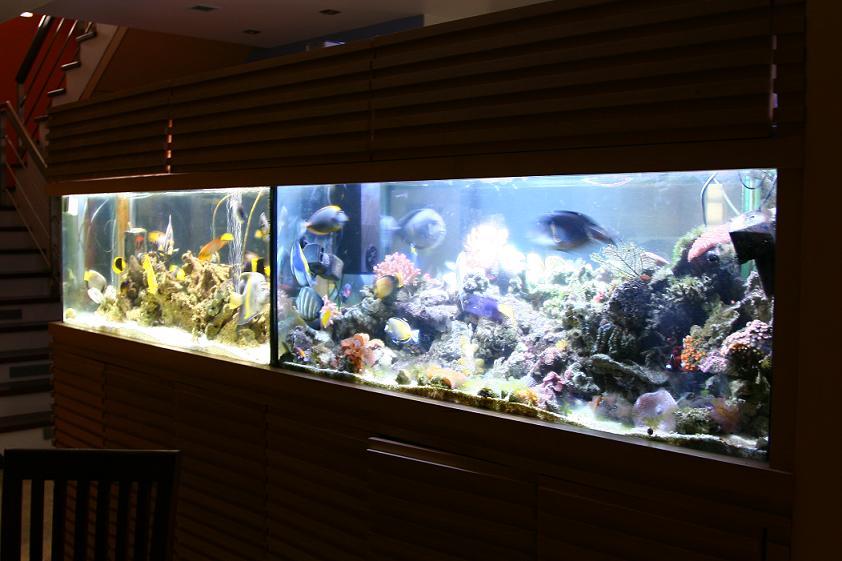
arg
SRC Member-
Posts
3,078 -
Joined
-
Last visited
Content Type
Profiles
Forums
Gallery
Everything posted by arg
-
The Aquarium Controller that I am using is Neptune Systems AquaController 3 together with the DC8 power block. The AquaController3 (AC3) monitors and controls temperature, pH, ORP. It has a timer function that can turn on or off devices multiple times in the day. The AC3 simulates sunrise and sunset and varies the lenght of the day according to the day of the year. It does the same for moonrise and moonset. Basically u can do the same light managemet as a Solaris lamp with any combination of MH, T5 and LED lights. The AC3 can control up to 20 pumps to turn on or off at fixed or random periods to create waves. It has a user specified variable feed timer cycle to turn off pumps during feding. The AC3 has a simple but powerful programming language to allow customizing the AC3 to control any device in the aquarium. U dont need a pc to program changes and u can do it thru the 3 button interface on the AC3. The AC3 polls water parameters and does data logging of temperature, pH and Orp and stores it in battery backed RAM. The data log can be viewed on the lcd screen or downloaded to a pc via a ethernet telnet or HTPP connection. The AC3 has an ethernet port and is networkable. When connected to my home network, I can access the status and configur the AC3 thru a standard web browser. With a streamyx connection, i am able to access the AC3 from anywhere in the world to access status and turn or off any device controlled by the AC3. It has a built in web server so u dont need a pc to serve its web pages. The AC3 is firmware upgradeable so it will not become obsolete. The AC3 allows hardware expansion so that u can have additional probes or control multiple aquariums. I have a couple of the expansion modules PX1000 to control my two old tanks. The AC3 can send email alerts when power fails or a critical parameter is breached like overheating. I was told by the Neptune guys that in the US u can send emails thru cellular networks to phones via sms. I have not been able to make this work in Malaysia. The AC3 is the brains of my aquarium. A pic of the AC3 and the PX1000 expansion module is attached below
-
The next step was to put in water. The main tank needed 2,378L (630G), the refugium needed 400L (100G) and the sump needed 500L (130G). I was collecting water from my old coral tank for weeks as well as preparing about 500G of fresh salt water. It took about a week to fill it up as my RO filter could only do about 60G a day. For wavemaking, I have a Wave2k box ordered fron the US. It uses a 110v motor and pulley system to pull in water and push it out. I got a step down transformer to power the 110v motor. It makes nice waves but it is a bit noisy. Unfortunately, I didnt take a picture of it before putting it in the tank and its hard to photograph in the tank. I am also using two Eiheim 1260 pumps connected to a couple of SCWD and loc-line outlets to provide change in water circulation direction. The loc-lines allow u to direct water to any dead spots. Pic of SCWD and loc-line attachment.
-
The main tank is 8'x3'x3.5' (LxWxH) or about 2,378L. The airline hose was fist put into the tank floor. Sand was put in next and dead rocks was then aquascaped in the tank. Since I was putting a lot of territorial fishes in the tank, I had to make sure that there were plenty of crevices or homes for the fishes. I am not sure how much rock i eventually used but it must have been at least a few hundred kg. I wanted colour in the rocks and so I got Walt Smith's Natures Image artificial coral for the tank. Altogether there must be at least 50 to 60 pieces. My wife thinks i probably over did it. Its probably true as I plan to put live corals in the tank too. pic of the main tank with "SPS" (Synthetic Polynmer Specimen) corals
-
The sump is 4'x2.5'x2' (LxWxH) and has 3 chambers. The water from the tank gravity feeds to the first chamber where the filter wool media is. The second chamber is the live rock chamber with about 50kg of live rock. The third chamber is where the Red dragon 14m3 return pump and the Eiheim 1262 pump to the refugium chamber sits. The refugium is on top of the sump and it is 3'x2.5'x2'. Right now has about 50kg of live rock. I will be moving some of this rock to the sump and placing rocks with plants in the refugium when I start moving livestock in the tank. The refugium is lighted by 4 flourescent tubes. I plan to put some "angel safe" corals in the main display tank. Right now I am experimenting by putting in the refugium, finger corals, buttons, elephant ear and a sea whip together with an Earspot angel, a Potteri Angel and a yellow Tang. So far, the Angels are not disturbing the corals. pic of the refugium without plants and with angels and corals.
-
The return pump originally was another Resun 18000 L/Hr pump. I replaced it with a Red Dragon 14m3 (14000 L/hr) pump. It can be placed out of water but I preferred the main return pump to be in the sump for safety. The Red Dragon 14m3 uses only 135W and generates little heat compared to the Resun pump that uses 250W power. The Red Dragon magentic drive pump produces little heat and no noise. I dont have a pic of the Red Dragon 14m3 as it is in the sump so here is a pic of the Red Dragon 10m3 that looks similar and will be the return pump for the sump of my new SPS tank.
-
The Solaris is not just an LED light fixture. Its an intelligent lighting system. U leave it on 24/7 and it manages lighting of your tank for u. It simulates sunrise, sunset, moonrise, moonset and even simulates cloud cover up to 5 times a day. The Solaris removes the need for timers, dimmers and LED lights for simulating moonlight. It allows u to set how long is the sunrise and sunset period and the light level for those periods. The Solaris has preset light level defaults, options for northern and southern hemisphere but if u prefer manual controls and doing things the hardway, u can manually adjust or turn things on or off if u dont like the light doing it for u. Below is a pc of the lcd screen and buttons of the Solaris controller.
-
I chose the new PFO Solaris LED lights to light up the new FOWLR tank because I needed lighting that can reach all the way down to the bottom of my 3.5 feet deep tank. Metal Halides would have generated and transfered a lot of heat to the water. LEDs shoot straight down and are very efficient. The 6 feet Solaris uses only 450w but is equavalent to 3x250W MH. U can adjust the Kelvin from 6.5K to 22K to suit your taste. Solaris LEDs are opposite to MH. The higher the Kelvin, the higher the PAR. Thus the 20k Solaris has higher PAR than the 13K Solaris pic of Solaris
-
The skimmer is a large 170cm (5 feet) high Aqua Macro venturi skimmer. I initially used a Resun 18000 L/Hr, >5m head pressure pump for the skimmer in the sump but it generarted too much heat. I changed it to a Sanso PMD-1511 Magnetic drive pump that I could put outside of the water. Heat problem solved and use half of the power of the Resun pump. Heat management in my opinion is often an overlooked but important consideration in Malaysia. Too much heat and u pay a lot of money for chilling and u have the risk that if your chiller fails for an extended time, your livestock gets cooked. pic of sanso pump.
-
-
The specs and equipment of my new FOWLR tank: FOWLR Tanks: 8x3x3.5 (LxWxH tank), 4x2.5x2 (sump), 3x2.5x2(refugium), Controller: Neptune AquaController3 and DC8, Ozonizer: Sander C300, Protein Skimmer: Macro Aqua ASF332 , Lighting: PFO Solaris-G-72-20k (Tank), T5-Happy Mouse Lighting HM-436 (Refugium), Chiller: Modified Split a/c with Resun Titanium coil, Fluid Reactor: 2xPhosban reactor, Skimz reactor with Sorb4, Skimz reactor with Zeovit carbon, Circulation and wavemaking Pumps: Wave2k box, Red Dragon 14m3 (Return), Sanso PMD-1511 magnet pump (Skimmer), 3x Eheim 1260 pump, 3x Eheim 1262 pumps, Air pump: Hiblow 40, Pic of my new tank being installed:
-
Once I moved the fishes to the new FOWLR tank, I am going to convert the two old tanks to SPS and soft & LPS tanks with expanded sumps in the filtration room. I am planning to make weekly 20% water change or 150L change for each coral tank. The 300L water from this coral tanks water change goes to another 100G tank where I use ozone to kill any disease carrying pests in the water. This water is used to do 10% water change of d new 3000L FOWLR tank. pic of my unfinished filtration room.
-
-
I decided to build a large display tank with an oversized sump and a new refugium to grow plants for food for my fish and filtration. I wanted to make basic husbandry easier so I decided to automate or make as much of the manual labour for water change dosing as easy as possible. I was filling up containers with RO water from my household drinking RO system, mixing salt and storing salt water for water changes. Very manual and time consuming. I decided to incorporate a dedicated RO system for my aquariums. I now have a 100G tank with a level switch to collect RO water automatically. I have another 100G mixing tank where I can pump the RO water to mix salt and store fresh salt water. The basic idea was to make water changes as easy and non messy as possible. The mixing tank pumps fresh salt water to the sumps of my tanks. pic of my 2 old tanks
-
Hi everyone! Have been a lurker in this forum for a while now and have not posted anything yet. Since its the start of a brand new year, I decided to share with my fellow reefers down south, the journey of setting up my new FOWLR aquarium. Lets start at the begining. I started with two 5 feet tanks joined together to create a 10 feet long display about 2 1/2 years ago. One was a FOWLR tank and the other a coral tank. I started collecting angels for the FOWLR tank and started putting some Tangs in the coral tank. Before long, the corals were for decorations and the Tangs was the focal point of my "coral" tank. the Tangs abd surgeons started to grow very fat and big in my coral tank. The Angels too started to grow too big for the 5 foot FOWLR tank. I decided to build a new tank to house all my angels and tangs. Today I have 20 large angels, 7 pygmy angels and 12 tangs and surgeons. Below is a picture of my two "old" tanks.













